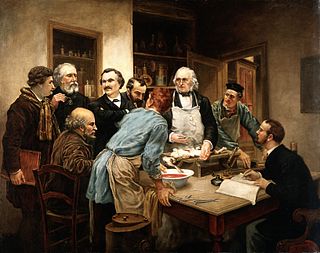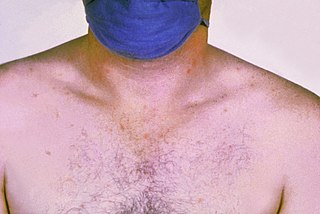
Zymotic disease was a 19th-century medical term for acute infectious diseases, especially "chief fevers and contagious diseases ".

Georg Ludwig Maurer, since 1831 Georg Ludwig von Maurer was a German statesman and legal historian from the Electoral Palatinate.

Karl Christoph Vogt was a German scientist, philosopher and politician who emigrated to Switzerland. Vogt published a number of notable works on zoology, geology and physiology. All his life he was engaged in politics, in the German Frankfurt Parliament of 1848–9 and later in Switzerland.

William Pulteney AlisonFRSE FRCPE FSA was a Scottish physician, social reformer and philanthropist. He was a distinguished professor of medicine at the University of Edinburgh. He served as president of the Medico-Chirurgical Society of Edinburgh (1833), president of the Royal College of Physicians of Edinburgh (1836–38), and vice-president of the British Medical Association, convening its meeting in Edinburgh in 1858.

Rudolf Friedrich Johann Heinrich Wagner was a German anatomist and physiologist and the co-discoverer of the germinal vesicle. He made important investigations on ganglia, nerve-endings, and the sympathetic nerves.
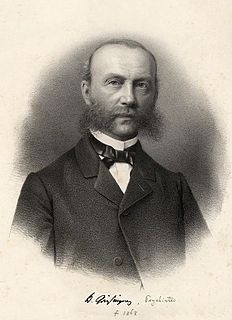
Wilhelm Griesinger was a German neurologist and psychiatrist born in Stuttgart.
Karl Friedrich Canstatt was a German physician and medical author.
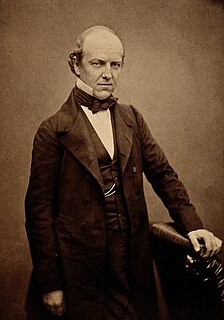
William Baly was an English physician.

Franz Karl Ludwig Wilhelm von Winckel was a German gynecologist and obstetrician who was a native of Berleburg.

Joseph von Lindwurm, was a German physician and dermatologist born in Aschaffenburg.

Karl Sebastian von Pfeufer was a German physician who was a native of Bamberg.
Constantine von Schäzler was a German Jesuit theologian.

The third cholera pandemic (1846–60) was the third major outbreak of cholera originating in India in the nineteenth century that reached far beyond its borders, which researchers at UCLA believe may have started as early as 1837 and lasted until 1863. In Russia, more than one million people died of cholera. In 1853–54, the epidemic in London claimed over 10,000 lives, and there were 23,000 deaths for all of Great Britain. This pandemic was considered to have the highest fatalities of the 19th-century epidemics.
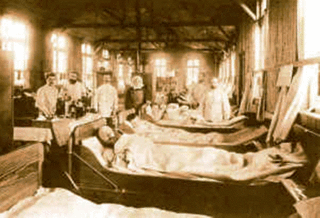
The fifth cholera pandemic (1881–96) was the fifth major international outbreak of cholera in the 19th century starting in India. It spread throughout Asia and Africa, and reached parts of France, Germany, Russia, and South America. The 1892 outbreak in Hamburg, Germany was the only major European outbreak; about 8,600 people died in that city. Although many residents held the city government responsible for the virulence of the epidemic, it continued with practices largely unchanged. This was the last serious European cholera outbreak of the century.
Otto von Schrön was a German physician and epidemiologist born in Hof, Bavaria.
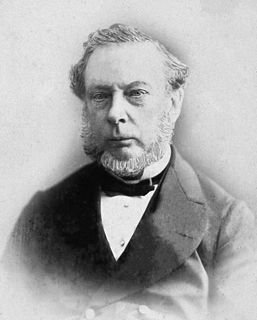
Thomas Bevill Peacock was a cardiologist in London remembered for founding the London Chest Hospital. He also made a large contribution to the understanding of aortic dissection by publishing several case series on the condition.

Diseases and epidemics of the 19th century reached epidemic proportions in the case of one emerging infectious disease: cholera. Other important diseases at that time in Europe and other regions included smallpox, typhus and yellow fewer.

Heinrich von Ranke was a German physiologist and pediatrician. He was the son of theologian Friedrich Heinrich Ranke (1798-1876) and the brother of anthropologist Johannes Ranke (1836-1916). Famed historian Leopold von Ranke (1795-1886) was his uncle.
Friedrich Wilhelm Hagen was a German psychiatrist. His father, also named Friedrich Wilhelm Hagen (1767–1837), was a noted clergyman.
Johann Baptist Friedreich was a German forensic physician and psychiatrist. He was a prominent member of the so-called "somatic school" of psychiatry in Germany.






